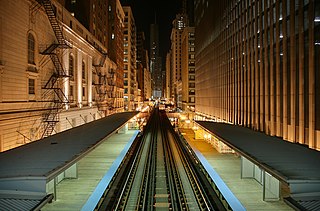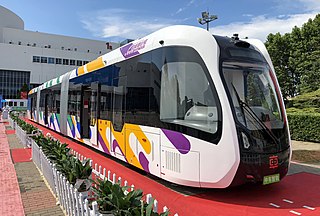
Light rail transit (LRT) is a form of passenger urban rail transit characterized by a combination of tram and rapid transit features. While its rolling stock is similar to that of a traditional tram, it operates at a higher capacity and speed and often on an exclusive right-of-way. In many cities, light rail transit systems more closely resemble, and are therefore indistinguishable from, traditional underground or at-grade subways and heavy-rail metros.

A rubber-tyred metro or rubber-tired metro is a form of rapid transit system that uses a mix of road and rail technology. The vehicles have wheels with rubber tires that run on rolling pads inside guide bars for traction, as well as traditional railway steel wheels with deep flanges on steel tracks for guidance through conventional switches as well as guidance in case a tyre fails. Most rubber-tyred trains are purpose-built and designed for the system on which they operate. Guided buses are sometimes referred to as 'trams on tyres', and compared to rubber-tyred metros.

A trackless train — or tram, road train, land train, or parking lot train is a road-going articulated vehicle used for the transport of passengers, comprising a driving vehicle pulling one or more carriages connected by drawbar couplings, in the manner of a road-going railway train. Similar vehicles may be used for transport of freight or baggage for short distances, such as at a factory or airport. Often depending on use, land train may or may not be skeuomorphically styled to look like traditional, often steam trains.

Guided buses are buses capable of being steered by external means, usually on a dedicated track or roll way that excludes other traffic, permitting the maintenance of schedules even during rush hours. Unlike railbus, trolleybuses or rubber-tyred trams, for part of their routes guided buses are able to share road space with general traffic along conventional roads, or with conventional buses on standard bus lanes.

The Société de transport de Montréal is a public transport agency that operates transit bus and rapid transit services in the urban agglomeration of Montreal, Quebec, Canada. Established in 1861 as the "Montreal City Passenger Railway Company", it has grown to comprise four subway lines with a total of 68 stations, as well as 212 bus routes and 23 night routes. The STM was created in 2002 to replace the Société de transport de la communauté urbaine de Montréal. The STM operates the most heavily used urban mass transit system in Canada, and one of the most heavily used rapid transit systems in North America. As of 2019, the average daily ridership is 2,297,600 passengers: 977,400 by bus, 1,306,500 by rapid transit and 13,700 by paratransit service.

Urban rail transit is a wide term for various types of local rail systems providing passenger service within and around urban or suburban areas. The set of urban rail systems can be roughly subdivided into the following categories, which sometimes overlap because some systems or lines have aspects of multiple types.
Various terms are used for passenger railway lines and equipment; the usage of these terms differs substantially between areas:

Public transport in Istanbul comprises a bus network, various rail systems, funiculars, and maritime services to serve the more than 15 million inhabitants of the city spread over an area of 5,712 km2.

A dual-mode vehicle (DMV) is a vehicle that can operate on conventional road surfaces as well as a railway track or a dedicated track known as a guideway. The development of these vehicles started together with personal rapid transport systems in the 1950s or even earlier.

Guided Light Transit was the name of guided bus technology and associated infrastructure designed and manufactured by Bombardier Transportation. It was installed in two French cities: Nancy and Caen. The Caen system was closed in 2017 and replaced by conventional trams, while the Nancy system was closed in March 2023 and is to be replaced by trolleybuses.

The Caen guided light transit or Caen TVR, locally known as "the Tram", was an electrically powered guided bus system in Caen, France, which used Bombardier Guided Light Transit technology.

The Toulouse Metro is a rapid transit system serving Toulouse Métropole, France. It is the only Metro system in Occitania. The city's public transport system was initially managed by the Société d'économie mixte des voyageurs de l'agglomération toulousaine, which was a company 80% owned by local government bodies and 20% privately owned. It has been managed by Tisséo Voyageurs, under the authority of Tisséo Collectivités, also named the Syndicat Mixte des Transports en Commun, an authority established by various local government bodies, since 2003.

A medium-capacity system (MCS), also known as light rapid transit or light metro, is a rail transport system with a capacity greater than light rail, but less than typical heavy-rail rapid transit. MCS's trains are usually 1–4 cars. Most medium-capacity rail systems are automated or use light rail type vehicles.

Rapid transit or mass rapid transit (MRT), also known as heavy rail or metro, is a type of high-capacity public transport that is generally built in urban areas. A rapid transit system that primarily or traditionally runs below the surface may be called a subway, tube, or underground. Unlike buses or trams, rapid transit systems are railways, usually electric, that operate on an exclusive right-of-way, which cannot be accessed by pedestrians or other vehicles. They are often grade-separated in tunnels or on elevated railways.

A rubber-tyred tram is a development of the guided bus in which a vehicle is guided by a fixed rail in the road surface and draws current from overhead electric wires.

Transport in Zagreb, the capital of Croatia, relies on a combination of city-managed mass transit and individual transportation. Mass transit is composed of 19 inner-city tram lines and 120 bus routes, both managed entirely by Zagrebački električni tramvaj. Croatian Railways manages the parallel Zagreb Commuter Rail system. The city is served by the Franjo Tuđman Airport, which carries more than 3,300,000 passengers per year.

Urban rail transit in India plays an important role in intracity transportation in the major cities which are highly populated. It consists of rapid transit, suburban rail, monorail, and tram systems.

Autonomous Rail Rapid Transit (ART) is a lidar guided articulated bus system for urban passenger transport. Developed and manufactured by CRRC through CRRC Zhuzhou Institute Co Ltd, it was unveiled in Zhuzhou in the Hunan province on June 2, 2017. ART has been described as a combination between a bus and a tram. Its exterior is composed of individual fixed sections joined by articulated gangways, resembling a rubber-tyred tram.
The following outline is provided as an overview of and topical guide to public transport:

















